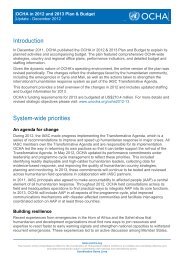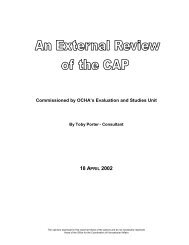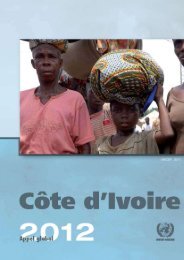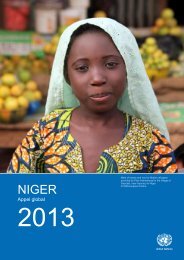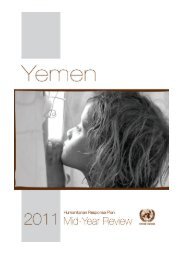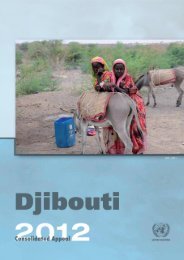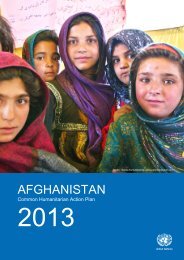SUDAN
Sudan: UN and Partners Work Plan 2012 - ReliefWeb
Sudan: UN and Partners Work Plan 2012 - ReliefWeb
- No tags were found...
Create successful ePaper yourself
Turn your PDF publications into a flip-book with our unique Google optimized e-Paper software.
50[3] Sector Response plans United Nations and Partners<strong>SUDAN</strong> WORK PLAN 2012EducationSummary objectives and information1. Increased access to life-saving education for the mostdisadvantaged and vulnerable pre-school and basicschool-aged children (including IDPs, returnees, refugees,nomads and host/rural underserved, especially girls)2. To improve quality of education and learning experiencein conducive environment for the most disadvantaged andvulnerable pre-school and primary school-aged children(including IDPs, returnees, and refugee children, especiallygirls)3. Increase access to quality non-formal/alternative life andlivelihoods skills-based learning opportunities for children,youth/adolescents at risk/out of school and adults4. Strengthen the capacity of local education stakeholdersand service providers to create access to life-saving qualityformal and non-formal education.Sector needs analysisSudan is home to more than 1.9million IDPs in Darfur and anadditional 2.3 million citizens are regarded as highly vulnerableand in need of humanitarian assistance in other areas. 18Close to 40 percent of the Sudanese population are childrenunder 15 years of age. As a result of recent conflicts in thethree Protocol Areas displacement has increased, resulting indecreased enrolment rates. Pressure on existing educationresources in neighbouring states such as White Nile, Sennarand North Kordofan to support the recently displaced is growing.Underinvestment in the education of children and youthrisks jeopardizing the future of millions of Sudanese children,as they grow up unskilled, poorly equipped for adult life,unhealthy and with significantly reduced chances of meaningfulfuture employment. 19 As funding contributions to Sudandiminish, the need for durable community-owned educationsystems capable of reaching out to children and youth remainsa humanitarian priority.Increased access to education for vulnerable anddisadvantaged school children%Keysector information (Education)Lead agency(s)Government leadSector memberorganizationsProjectsBeneficiariesFunds requestedFunds requested perpriority levelContact infoUN Children's Fund - UNICEFSave the Children (co-lead)Ministry of General EducationAl Massar Charity Organization for Nomads,AlRahma Islamic Organization, Care Switzerland,Catholic Relief Services, FPDO, Global HopeNetwork International, GOAL Ireland, GrantFamilyOrganization,Hiba,Hidaya RehabilitationOrganization for Special Needs,Human ReliefFoundation,International Development andRelief Board,ILO, InterSOS Humanitarian AidOrganization, Islamic Relief Worldwide, JesuitRefugee Services,NCA, Peace Corps, PeacePlatform Organization, Plan Sudan,Salam forRehabilitation,SC, Sudan Council of Churches,Sudan Open Learning Organization,SudanAid,Sudanese Development Call Organization,Sudanese Network for Education for AllSudaneseWomen’s General Union,Tearfund, United MethodistCommittee for Refugees, United NationsChildren’s Fund, United Nations High Commissioneron Refugees,VolontariatoInternazionaleper lo Sviluppo, War Child Canada, War ChildHolland, World Food Programme, World Vision,ZOA Refugee Care.35 projectsTarget is• 150,000 vulnerable pre-school and schoolchildren• 80,000 out-of-school children and youth• 350,000 primary school children• 1,154,678 basic school children in need ofschool meals• 5,000 teachers• 5,000 illiterate adult women and men• 40 Government employees• 700 members of Parent/Teacher Associations• 210 NNGO/CBO representatives$78.65 million$37.74 million (high)$40.91 million (medium)Friedrich Affolter: faffolter@unicef.org;Wigdan Adam: WigdanA@ecaf.savethechildren.se.Vulnerable children such as IDPs, returnees, refugees, nomads,orphans, children with special needs, and children from ruralunderserved communities are less likely to access educationservices. Indeed, a poor rural girl’s chances to access qualityeducation schools is 25 percent lower than that of a boy froma middle-class urban family. 20 Vulnerable children require qualityschools or learning spaces, as well as trained teachers andOut-of-school childrenChildren who never attened school (%)Percentage of children (6-13 and 14-16-year-olds) who never attended school6-13 years 14-16 years27.120.9 21.318.713.4 13.112.2 12.86.6 7.642.6 43.4 44.4 46.748.0 50.5 51.647.2 45.1 46.741.531.5 33.1 34.2 32.7 33.8 35.828.622.6 24.7Out-of-school children per population type% of children who never attended school (all Sudan)6-13 14-16 years36.428.679.679.6KhartoumNorthernGeziraRiver NileW. NileSinnarGedarefN. DarfurBlue NileN.KordofanS.KordofanKassalaRed SeaW. DarfurS. Darfur15.68.5Urban Rural NomadSource: CBS (2009), Sudan census; UNICEF (2011)




